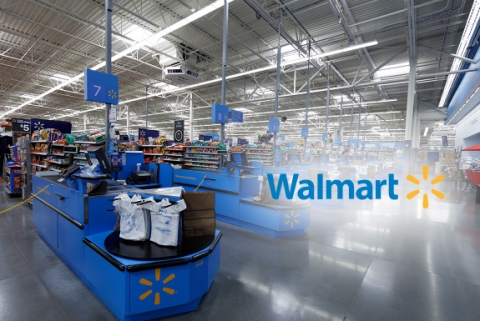The Big-Box Efficiency Project evaluated the impacts of installing an integrated suite of pre-commercial energy efficiency technologies at an existing Walmart Supercenter in Southern California. Electricity use was cut by more than 30%, demonstrating a path for retrofitting other large retail stores to save energy and reduce emissions.
The Big-Box Efficiency Project evaluated the benefits of combining five different energy efficiency measures:
- Efficient, direct current-capable LED lighting.
- Smart motors for refrigeration and heating, ventilation and air conditioning.
- Precooling outside air using water and evaporation to reduce electricity needed for air conditioning.
- Smart water management to reduce waste.
- An Internet of Things building energy management systems platform to analyze data and identify energy savings opportunities.
The project was funded by a $2.8 million grant from the California Energy Commission to the Center for Sustainable Energy (CSE) in partnership with Walmart, Southern California Edison and other key participants.
“The Center for Sustainable Energy has collaborated with Walmart every step of the way in a demonstration project to help validate the savings potential of pre-commercial energy efficiency technologies. We value CSE’s deep expertise and experience in guiding the project and identifying key lessons that can be applied to similar projects as we work toward a zero-emissions future,” Bob Stone, Sr. Manager, Renewable Power & Energy Efficiency, Walmart Energy

Big-Box Efficiency Project Impacts
zero-emissions plan
Program at a Glance
Program Goals
Demonstrate the effectiveness of precommercial energy efficiency technologies to achieve at least a 20% reduction in electricity consumption.
CSE's Role
Prime contractor/project management
Site characterization
Measurement & verification
Technology knowledge transfer
Technologies
Key Partners
Walmart, National Renewable Energy Laboratory, TRC Energy Services, P2S Engineering Inc., Southern California Edison, Davenergy Solutions, Emily Grene, Locbit, i2 Systems, Turntide by Software Motor Company, Integrated Comfort Inc. and SAYA.
State Policies Supported
California Senate Bill 350
CPUC proceedings: demand response, energy efficiency and integrated distributed energy resources
Impact Statement
Savings Goal = > 20% electric energy savings
After project installations, whole-building electrical savings from the new technologies were 22.5% with an additional 9.9% from unidentified end uses for a total of 32.4% savings.

